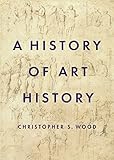A history of art history / Christopher S. Wood.
Material type: TextLanguage: English Publisher: Princeton : Princeton University Press, 2019Copyright date: ©2019Description: 461 pages : illustrations ; 25 cmContent type: text | still image Media type: unmediated Carrier type: volumeISBN: 9780691156521 (hardback)Subject(s): Art -- History | Art -- Historiagraphy | ArtLOC classification: N7480 .W673 2019Subject: "In this wide-ranging and authoritative book, the first of its kind in English, Christopher S. Wood tracks the evolution of the historical study of art from the late Middle Ages through the rise of the modern scholarly discipline of art history. Synthesising and assessing a vast array of writings, episodes, and personalities, this original and accessible account of the development of art-historical thinking will appeal to readers both inside and outside the discipline"Subject: "In this authoritative book, the first of its kind in English, Christopher Wood tracks the evolution of the historical study of art from the late middle ages through the rise of the modern scholarly discipline of art history. Synthesizing and assessing a vast array of writings, episodes, and personalities, this original and accessible account of the development of art-historical thinking will appeal to readers both inside and outside the discipline. The book shows that the pioneering chroniclers of the Italian Renaissance--Lorenzo Ghiberti and Giorgio Vasari--measured every epoch against fixed standards of quality. Only in the Romantic era did art historians discover the virtues of medieval art, anticipating the relativism of the later nineteenth century, when art history learned to admire the art of all societies and to value every work as an index of its times. The major art historians of the modern era, however--Jacob Burckhardt, Aby Warburg, Heinrich Wölfflin, Erwin Panofsky, Meyer Schapiro, and Ernst Gombrich--struggled to adapt their work to the rupture of artistic modernism, leading to the current predicaments of the discipline. Combining erudition with clarity, this book makes a landmark contribution to the understanding of art history."
TextLanguage: English Publisher: Princeton : Princeton University Press, 2019Copyright date: ©2019Description: 461 pages : illustrations ; 25 cmContent type: text | still image Media type: unmediated Carrier type: volumeISBN: 9780691156521 (hardback)Subject(s): Art -- History | Art -- Historiagraphy | ArtLOC classification: N7480 .W673 2019Subject: "In this wide-ranging and authoritative book, the first of its kind in English, Christopher S. Wood tracks the evolution of the historical study of art from the late Middle Ages through the rise of the modern scholarly discipline of art history. Synthesising and assessing a vast array of writings, episodes, and personalities, this original and accessible account of the development of art-historical thinking will appeal to readers both inside and outside the discipline"Subject: "In this authoritative book, the first of its kind in English, Christopher Wood tracks the evolution of the historical study of art from the late middle ages through the rise of the modern scholarly discipline of art history. Synthesizing and assessing a vast array of writings, episodes, and personalities, this original and accessible account of the development of art-historical thinking will appeal to readers both inside and outside the discipline. The book shows that the pioneering chroniclers of the Italian Renaissance--Lorenzo Ghiberti and Giorgio Vasari--measured every epoch against fixed standards of quality. Only in the Romantic era did art historians discover the virtues of medieval art, anticipating the relativism of the later nineteenth century, when art history learned to admire the art of all societies and to value every work as an index of its times. The major art historians of the modern era, however--Jacob Burckhardt, Aby Warburg, Heinrich Wölfflin, Erwin Panofsky, Meyer Schapiro, and Ernst Gombrich--struggled to adapt their work to the rupture of artistic modernism, leading to the current predicaments of the discipline. Combining erudition with clarity, this book makes a landmark contribution to the understanding of art history."
| Item type | Current library | Shelving location | Call number | Status | Date due | Barcode |
|---|---|---|---|---|---|---|
| Books | MEF Üniversitesi Kütüphanesi | Genel Koleksiyon | N 7480 .W673 2019 (Browse shelf (Opens below)) | Checked out | 22.05.2025 | 0020322 |
Includes bibliographical references (pages 409-443) and index (pages 445-459).
"In this wide-ranging and authoritative book, the first of its kind in English, Christopher S. Wood tracks the evolution of the historical study of art from the late Middle Ages through the rise of the modern scholarly discipline of art history. Synthesising and assessing a vast array of writings, episodes, and personalities, this original and accessible account of the development of art-historical thinking will appeal to readers both inside and outside the discipline"
"In this authoritative book, the first of its kind in English, Christopher Wood tracks the evolution of the historical study of art from the late middle ages through the rise of the modern scholarly discipline of art history. Synthesizing and assessing a vast array of writings, episodes, and personalities, this original and accessible account of the development of art-historical thinking will appeal to readers both inside and outside the discipline. The book shows that the pioneering chroniclers of the Italian Renaissance--Lorenzo Ghiberti and Giorgio Vasari--measured every epoch against fixed standards of quality. Only in the Romantic era did art historians discover the virtues of medieval art, anticipating the relativism of the later nineteenth century, when art history learned to admire the art of all societies and to value every work as an index of its times. The major art historians of the modern era, however--Jacob Burckhardt, Aby Warburg, Heinrich Wölfflin, Erwin Panofsky, Meyer Schapiro, and Ernst Gombrich--struggled to adapt their work to the rupture of artistic modernism, leading to the current predicaments of the discipline. Combining erudition with clarity, this book makes a landmark contribution to the understanding of art history."
